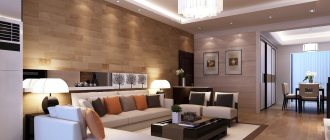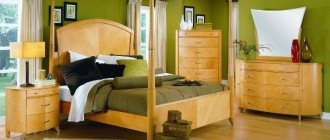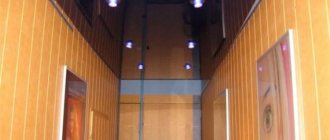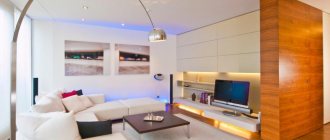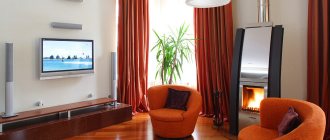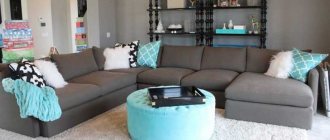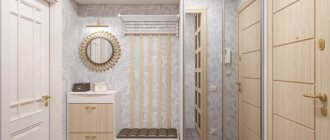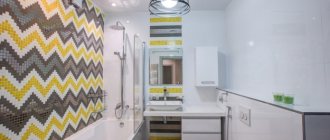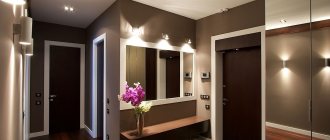Light zoning has long been used in the design of residential and work spaces, because the right combination of natural and artificial light can transform any space. Lighting in an apartment requires careful preparation and adherence to certain design rules. A well-chosen scheme can visually increase the area of the room and hide design mistakes, while an unsuccessful one will only aggravate the interior’s shortcomings. In this article we will look at how to choose light sources for different rooms, and also analyze current trends in this direction.
How to properly organize lighting?
Lighting planning is an integral part of renovation work. This process must be started at the design stage. The organization of light in an apartment should begin with dividing the room into several thematic zones. In the classic version, lighting is divided into two types: general (basic) and local.
Local lighting is intended to illuminate specific interior elements or corners of the apartment, while general lighting serves as a key element of artificial light.
In turn, local illumination is of the following types: working and spot. Most rooms provide a so-called work area (kitchen table, office, children's play corner). To ensure sufficient illumination, large chandeliers, floor lamps and sconces are used.
Spot light supply is most often used as an additional element; it performs a purely decorative function.
A distinctive feature of artificial light is the ability to use it at any time of the day or night. By changing the color of the light zoning, you can instantly change the proportions of the room and divide the room into functional zones.
It is also worth noting that the shade of light greatly affects the human perception of reality. Let's give an example: green color calms, and yellow uplifts. Thus, when choosing a lighting scheme in an apartment, it is necessary to take into account the functionality, safety and aesthetics of the design.
Power standards and number of lamps
To achieve the most efficient and comfortable lighting in the interior of an apartment, you should take into account uniform standards for the power and number of lamps in the illuminated area. Thus, experts advise placing devices with a power of about 70 kW for every five square meters of the room. This indicator may vary depending on the specifics of the room. Moreover, we are talking only about central lighting; it can be supplemented with various kinds of decorative or point light sources.
Having studied the basic requirements for illumination of residential premises, you can independently calculate the required number of lamps for the apartment. You are also free to use all sorts of design tips. Most often, they consider the organization of electric lighting in studio apartments.
For a one-room home with an area of 30 square meters, you need about eight lamps (one central chandelier, task lighting, three spotlights, a floor lamp and several sconces).
Example of lighting in a one-room apartment
How to check the quality of light?
When purchasing a chandelier or any other lighting fixture, you first need to find out what kind of lamp is used in the installation. The most common option is an incandescent lamp - it gives a bright, uniform glow. However, the disadvantage of this type of device is the rapid consumption of electricity.
Today, most lighting companies are switching to energy-saving lamps. Their cost is slightly higher, but reliability and low electrical costs worry buyers no less than the price.
There is one simple way to check the quality of light in a chandelier; for this you will need a mobile phone. Hold the device close to the light fixture and turn on the camera, watching the moving light bars on the screen. If you notice significant flickering and numerous streaks, know that the quality of the light leaves much to be desired. In this case, it is better to immediately replace the product, because over time you and your family members may begin to have vision problems.
Colorful temperature
As already mentioned, the color temperature of the lamps plays an important role in light zoning. There are three colors: warm white (up to 3300 K), standard white (up to 5000 K) and cool white (from 5000 K). In accordance with European standards, it is customary to use warm white light in living rooms, but in secondary rooms, such as the hallway, it is recommended to use classic white.
Article on the topic: Features of lighting in the kitchen: what is it and how to organize it? (current ideas)
Variability of light
The light in all rooms should be variable. Solutions that adjust the light environment in the room in accordance with natural human biorhythms are gaining great popularity in this matter.
It's no secret that our eyes were formed in natural light - sunlight.
The sun changes its color temperature over a fairly wide range. In the morning, afternoon and evening, a completely different light emanates from it.
At home, we can also simulate the change in color temperature over time so that it matches our natural biorhythms. This lighting system increases performance, makes you feel better, and reduces eye fatigue.
This system is very simple and you can create a light environment in your room with a slight movement of your hand:
- cold
- or warm
In addition, this process can be automated. It is enough to link LED sources to light sensors and a timer, and the system itself will change the color temperature at the right time.
Sources of light
Today, a variety of light bulbs, all kinds of chandeliers, sconces and floor lamps are used to illuminate apartments. Specialized stores in Moscow and other large Russian cities offer a wide selection of similar products for every taste and budget.
The following are used as a direct light source:
- incandescent lamps;
- LED devices;
- fluorescent lamps;
- optical fiber;
- metal halide light bulbs;
- halogen bulbs.
All of the above types have both advantages and disadvantages of use. Let's take a simple example: previously popular incandescent lamps do not correspond to modern trends, since they consume a large amount of electricity and the quality of light is very low.
Natural light
The best decoration for a wooden country house, or even an ordinary apartment, is natural lighting. It not only does not harm vision and has a positive effect on people’s well-being, but also looks impressive in any interior. To fully enjoy living light, private houses have full-wall windows; it looks simply amazing. However, this effect is very difficult to achieve in a one-room or two-room apartment.
Artificial lighting
There are many options for lighting in an apartment, but not everyone suits the chosen style of the room. It is worth remembering that artificial light involves not only the installation of expensive lamps. This process should be approached responsibly, because the health of a person’s eyes and nervous system depends on the final result.
To create a functional light zoning system for an apartment, you need to familiarize yourself with the installation capabilities of the devices in advance. The photo below shows a universal living room design using different types of lamps.
On video: what you need to consider when designing lighting.
Types of lighting
There are four types of artificial light: general, local, combined and emergency. The latter type is not often found in residential premises, but it is indispensable in rooms where turning off the lights threatens serious injuries. Next, we will consider all types of lighting in apartments in more detail.
General or basic lighting involves uniform (directional) dispersion of light across the entire area of the room. Most often this type is used in living rooms and kitchens. Due to the same distance between the lamps, an optimal level of illumination is achieved. Another option for such light zoning is a single light source localized at one point. As an example, there is a large chandelier located in the center.
Local lighting in the apartment is used to attract attention to certain parts of the room. Thus, the light source is located directly next to the illuminated piece of furniture (on the desktop, in the sleeping area or in the kitchen). As the designers note, it is this type of light zoning that brings completeness and integrity of perception to the interior space.
Separately, general and local lighting have certain functional disadvantages. That is why a combined light zoning scheme was developed.
Spotlights
Since then, when European-quality renovations began to be carried out everywhere in Russian apartments, spotlights have appeared on ceilings, walls and decorative objects. Such built-in lighting fixtures are becoming more and more popular over time. Now you won’t surprise anyone with a multi-level ceiling with halogen light bulbs.
It is worth noting that there are two types of spotlights - fixed and rotating. The latter are very convenient to use, and if desired, you can change the direction of the light yourself.
When choosing such devices, pay attention to the beam width. Let's give an example: 40-50 degrees is great for highlighting large objects, and halogens with a beam of 10-20 degrees are suitable for minor decorative elements.
Neon lamps
Neon lighting is a special type of artificial light, which is a gas-discharge lamp in the shape of a tube (neon is contained inside at low pressure). The “native” shade is bright orange, but the color of the backlight may change depending on what inert gases are added to the composition.
A neon lamp will help bring color to the interior of your apartment. The photo below shows the lighting design in the apartment in pink and purple tones.
LED strips
Recently, various LED devices have been used for decorative lighting of rooms. The most popular is LED strip. This is a flexible board covered with LEDs. Bright neon colors, unusual appearance and low price - all this makes this light source an excellent addition to the exterior lighting of a wooden house.
For interior decoration, such lighting can be used both on the ceiling, walls, and on small built-in structures. For greater effect, you can arrange the feed in the form of graphics, thereby creating a unique atmosphere.
LED duralight
For additional illumination of individual parts of the room, various LEDs are used, as well as a new product on the market, “duralight”. This functional device is a flexible cord made of elastic plastic. A continuous garland of LED light bulbs is pressed into the base.
Related article: Lighting in the corridor: stylish solutions for large and small apartments (+62 photos)
Flexible neon
It is also a flexible tube, inside of which a lighting circuit is fixed. This is nothing more than an electroluminescent wire. Outwardly, it is really no different from a regular wire - it is just as flexible, it can even be tied into a knot.
Unlike LED strips, flexible neon glows from all sides, it is safe and even waterproof, and has a wide range of applications.
The versatility of modern lighting design solutions
In any room, general lighting should be correctly combined with task and accent, local and combined. They have their own subtypes and varieties. If the general one should, let’s say, get rid of darkness as a whole, then the other devices have the function of highlighting individual elements. This is achieved by using different light sources in the room, regardless of the overall design.
LED lighting in the living room interior
Types of artificial light sources:
- LED lamps are a modern alternative to the classic “Ilyich bulbs,” the use of which is expensive today.
- Incandescent lamps are considered archaic, but they cause minimal strain on vision, and their spectrum imitates the sun's rays as much as possible.
- Energy-saving lamps are quite economical, but their frequent flickering tires the eyesight; they are offered with a “warm” and “cold” spectrum.
- Fluorescent lamps are most often used for retail and industrial spaces, but these lamps also find worthy use in “studio spaces” without walls (simulating daylight).
- Light-emitting cords "duralight" based on LEDs are an excellent way to decorate individual elements of the interior and external lighting, complementing the original design of the light in the apartment.
- Bright halogens have different shades of light; these lamps are widely used in decorating spaces.
LED strips allow you to organize any decorative lighting options for ceilings, walls and furniture
When calculating the total intensity, the solution of suspended ceilings is taken into account. The lighting design in the bedroom and living room using multi-level structures is self-sufficient, with the exception of adding devices for local areas.
See alsoKitchen design in a wooden house with stylistic options
Lamp placement options
The main rule of design is that bright light increases the space. It follows from this that the finishing of the ceiling and walls should be done using all kinds of reflective materials. Lamps directed upward visually make the ceiling higher. And to darken part of the room, you just need to correctly distribute the light sources around the room.
New ideas in lighting design state that universal electric lighting at home should combine general and local (spot) lighting. This is guaranteed by the so-called multi-level zoning.
There are no strict rules for organizing electric lighting in apartments, but there are certain tips that should be followed when planning the interior yourself.
Living room (hall)
The main source of light in the room is central lighting; this can be a luxurious chandelier or a series of spotlights laid out around the perimeter of the room. For classic interiors, the first option is suitable, but when arranging modern apartments, you should first of all focus on the preferences and material capabilities of the residents.
For a living room (hall) in a high-tech style, neon lamps, LEDs, and even a light floor are suitable.
Bedroom
As in other living spaces, it is best to use combined lighting in the bedroom. A chandelier and several floor lamps are suitable as base light, and spotlights along the perimeter of the ceiling will only complement the overall picture. You can also transform your bedroom with the help of local lighting fixtures - they are very inexpensive, and the range of their purposes is very diverse.
Children's
The child spends most of his time in his room. This determines a large number of requirements for the lighting design of a nursery. It is necessary to choose lighting fixtures of suitable power and shade, because the mood and psychological health of the baby depend on proper planning. Particular attention should be paid to decorative lighting in a children's room. The photo below shows options for light zoning for children's rooms.
Kitchen
The kitchen is characterized by multi-level lighting. It involves a visual division of the room into functional areas: dining room, workplace and relaxation area. In the kitchen, it is necessary to provide the ability to regulate the brightness of the light - this is especially important for the dark time of day.
In the kitchen, the selected type of lighting can work independently of other lighting elements. Even if the room only has central lighting, make sure that it can be turned on in parts.
Hallway
There is absolutely no natural light in the hallway and corridor, so the room needs a large number of built-in lamps. There are no special requirements for organizing light in the corridor; everything depends only on the tastes of the residents.
Bathroom
There is no natural light in the bathroom (no windows), due to which the role of artificial light increases significantly. The use of local high-power appliances is unacceptable for the bathroom. The backlight should be sufficient, but not too bright. When choosing bath fixtures, it is necessary to take into account the increased humidity of the room.
Light zoning in a studio apartment
Most often, light zoning is used specifically in studio apartments, since in such rooms there is a problem of lack of free space. Dividing the apartment into thematic zones allows you to visually increase the area of the room and give the home a logical completeness.
In such conditions, you can experiment with lighting devices - use local devices, large chandeliers, and decorative elements.
Lighting design for individual rooms: simple and complex
Light is not only functional, but also beautiful. Famous designers and architects will definitely take this important component into account when taking on a new project. A competent project will make your stay in the house comfortable and will help visually correct the space.
Each lamp in the room should have its own purpose.
Some elements can be shaded, others can be highlighted and draw maximum attention to them; a certain vector is set with directional light to “move away” or “bring closer” an object in the interior. Soft neon light creates an unusual effect when turned on from the head of the bed, the back of upholstered furniture, a plasma panel or along the perimeter of the “floating” ceiling. In this case, you don’t have to use a chandelier or other “classic” source of general light.
The light in the hallway is usually completely artificial; in the apartment the front door is removed from all windows. You can limit yourself to one luminous point near the ceiling if it is a tiny room. In the hallway combined with the corridor, make 3-4 dim lamps or sconces along the entire passage. For decorative purposes, you can use LED strip to decorate the baseboard and ceiling cornice. It is advisable to provide lighting to the mirror and the interior of the wardrobe. In a long corridor, a luminous path on the floor would be appropriate, and in a spacious room, a suspended ceiling with a beautiful lighting design would be appropriate.
To shorten a long hallway, you can place built-in lights along the ceiling and direct the light down
The bedroom is a special room where an intimate atmosphere is appropriate, which is created, to the greatest extent, by the play of light and shadow. The design depends on the size of the bedroom, interior style and furniture configuration. The classic version uses an elegant ceiling chandelier and 2 sconces (on both sides of the bed), while the modern version uses a variety of suspended ceilings and LED lighting (at the mirror and head of the bed). They often combine a ceiling with a “starry sky” effect and perforated sconces with openwork reflections on the wall. Some people like semi-darkness in their bedroom. But you don’t have to limit yourself to these ideas; the decision depends on the style and overall design concept, as in the photo.
Dim lighting is appropriate in the bedroom
In a modern living room, the main lighting design of the apartment is given to suspended or multi-level ceilings. If the classic version plays up the color of the ceiling and the shape of the chandelier, then new solutions in the age of high technology are unlimited. Buy a relatively simple lamp that can be switched from a remote control, or choose combination lighting with lower lighting for furniture.
In the living room, several types of lamps are used in accordance with the style direction of the room
The bathroom and toilet are a special room where you can experiment with lighting, which is unacceptable in a residential area. Try lights that gradually turn on and off, turn on with a clap, and more. It is important to take into account that this is a place with high humidity; wiring, lamps and lampshades should be as sealed as possible. LEDs near the mirror and bathroom are appropriate. For expensive hot tubs, this is the default option.
In the bathroom you need fairly bright light, but not harsh. Matte lamps built into the ceiling and a couple of devices for mirror illumination are suitable.
Light in the kitchen involves several zones with economical local lighting. This is a working plane and a place for eating, in addition to general light. Some people like large lampshades that flow down from the ceiling to the dining table. In a modern kitchen, you can make a frame near the ceiling with directed ray vectors. A gas stove with a backlit oven looks original - you and your guests can watch the process of frying chicken rotating on the grill. Additionally, diodes are appropriate at the bar counter and above the sink.
In the kitchen, directional lighting of work areas is combined with diffused light above the common space
Soft light in a children's bedroom is the basis of the design for this room. Rays that are too bright are harsh for the baby’s vision and irritate the psyche. And a deficiency can provoke myopia if children like to write, read and draw in the evenings. In places where they do homework or study at the computer, be sure to organize local lighting. An original night light with a children's theme will eliminate the fear of the dark at night, but it will not interfere with sleep if placed on the opposite side of the baby's eyes.
The children's room needs a high level of lighting, but without bright rays
In a studio apartment, everything depends on the local zones, but it is better if this is reflected in the design of the ceiling structure. Any accent can be the highlight of the concept, but do not forget that each functional area must have controlled power and intensity of the rays. For a large area, switches from different points to the general light or remote control are appropriate.
Additional lighting of individual zones is added to the main general light
Finally, one more important point - no matter how ideally artificial lighting is organized, do not forget about natural light, which plays a significant role in the design of a living space
The proposed examples in the photo will help you adopt ideas used by professionals.
See alsoFeatures of kitchen design with a bay window
Ceiling lighting
Modern lighting design ideas give a special role to ceiling lighting. In most cases, the choice of lighting fixtures evokes positive emotions, but placing purchased light bulbs and hiding them (when creating hidden lighting with your own hands) is not always easy. Before starting the installation of spots, it is recommended to identify three main light sources in the interior (local, local and decorative).
For low ceilings
If the ceiling in the apartment is quite low, then there can be no talk of any tension or even suspended structures. Hanging chandeliers and massive lamps are not suitable. Recessed spotlights cannot be built in here, but overhead versions can be installed. Flat-shaped ceiling chandeliers, track lighting systems and LED panels will fit harmoniously.
Hidden ceiling lighting
You can build two types of hidden lighting with your own hands: using a niche made of plasterboard and with a cornice made of polystyrene foam. And the combination of a plasterboard box and a stretch ceiling with hidden lighting perfectly hides minor errors that occur when constructing a ceiling yourself.
Related article: Lighting for a children's room: tips on organization
Multi-level lighting
For a comfortable stay, you cannot do without proper lighting of the room. For more than ten years now, all designers have been leaning in their work towards a multi-level light system in apartments. Such light zoning represents the optimal division of space into several functional zones.
It is customary to distinguish four main levels:
- upper (spots, sconces and chandeliers);
- medium (lamps, floor lamps);
- bottom (local illumination);
- internal (used to highlight dressing rooms and closets).
Multi-level zoning of rooms using light does not require special skills and knowledge. If you wish, you can radically transform the appearance of your living room or children's room with your own hands. To do this, you will need a little imagination and a set of lighting fixtures with different functionality. A competent combination of chandeliers, spots on the walls and floor will bring comfort and tranquility to your home.
In the video: multi-level lighting in the apartment.
Tips for Effective Living Room Lighting
The darker the room, the more lighting fixtures. Artificial lighting creates a cozy atmosphere both in the evening and during the day. If the room is bright, then additional elements are unnecessary. Designers recommend a central chandelier and a floor lamp (table lamp) in the recreation area.
Lighting under the ceiling and on the shelves Source doma.life
Interior in light colors Source locationdesign.net
Floor lamps are suitable for a romantic setting. Built-in lamps or spots with a rotating mechanism illuminate large objects (furniture, appliances, plants) and create a comfortable atmosphere. The lower light does not interfere with watching TV, so it is appropriate in a recreation area.
Beautiful neon lighting in the living room interior Source www.pinterest.com
Smart lighting in the living room helps you control electrical appliances remotely using a gadget. Lights with a motion sensor light up when a person appears and deactivate after a few seconds of inactivity. Sound elements react to voice (clap of palms), reduce intensity or turn off the backlight.
Dim light in a studio apartment Source www.installation-international.com
Smart light switch Source fockenbrock.ms
Sconces are a convenient electrical appliance that is often used in interior design. If you place the component next to a TV or monitor, the glare will interfere with comfortable viewing. Lamps are best used for recreation areas, in the dining room and on the walls next to paintings.
Wall lamps in the living room Source www.totalconstrucao.com.br Wall sconces Source mobilyamarketim.com
Living room with fireplace Source sealimport.info
To prevent the living room from looking vulgar, you cannot use a lot of decor. A model of a lamp (chandelier) of an original shape is a bright and main element in the design. The decoration is suitable for laconic styles with a minimum of components. If there are an abundance of details, it is better to use simple lamps.
Crystal chandelier in the interior of the hall Source www.houzz.ru
Hall design in a classic style Source en.eyeni.site
If the room has glossy walls and furniture fronts, then it is appropriate to hang one large chandelier. A classic electrical appliance is placed in the center of the ceiling. Matte surfaces do not reflect light, so point elements around the perimeter and floor lamps are allowed.
Panoramic windows in the living room Source www.pinterest.com
Decorative lighting
An inexpensive LED strip is most suitable for decorative lighting. The positive features of this product include ease of use, easy and quick installation. If the interior of the room is made in a classic style (with wooden furniture, pastel shades of the walls and tapestry), then the LEDs are replaced by local lamps and special luminous elements for decoration.
A distinctive feature of decorative lighting is the specificity of its use. It is used when it is necessary to hide lamps and make the light more subdued.
Neon lighting in the apartment
Such decorative lighting can be arranged using various LED and LED devices. Most often they are installed in suspended ceilings, in plasterboard niches. Flexible tubes or cords that glow with neon are often used.
Glass blocks in the interior of an apartment with lighting
Glass blocks are hollow cubes with glass walls about one centimeter thick. In Soviet times, such decorative elements were often used; they could be seen in the interior of bathhouses, hospitals, and staircases. Today, glass blocks have been improved - they are equipped with decorative lighting.
Floor lighting
Floor lighting is another solution with which you can give the room an unusual look. Various devices are used for lighting, these can be spotlights, LED strip, duralight cord, which are mounted in the plastic baseboard case or in glass floors.
Modern lighting trends
Lighting design is a unique combination of technological advancement and artistic planning. All new design trends come first to the light zoning of rooms, and then spread to the entire interior. A distinctive feature of modern design is high functionality; this is the so-called smart design, which is aimed at satisfying all the needs of its owner. This trend is called lighting personalization.
If you carefully study the appearance of modern lamps, it becomes clear that they have completely lost clearly defined boundaries. Nowadays, round, asymmetrical, small-sized built-in spots are especially popular in interior design. Track systems have become an integral part of the ceiling, which has also lost its boundaries.
Night lighting in the apartment
Night lighting is not a significant necessity when decorating interior spaces. However, it allows you to avoid accidents in the dark. You can install night light along the perimeter of strategic movement or in separate areas of the room.

